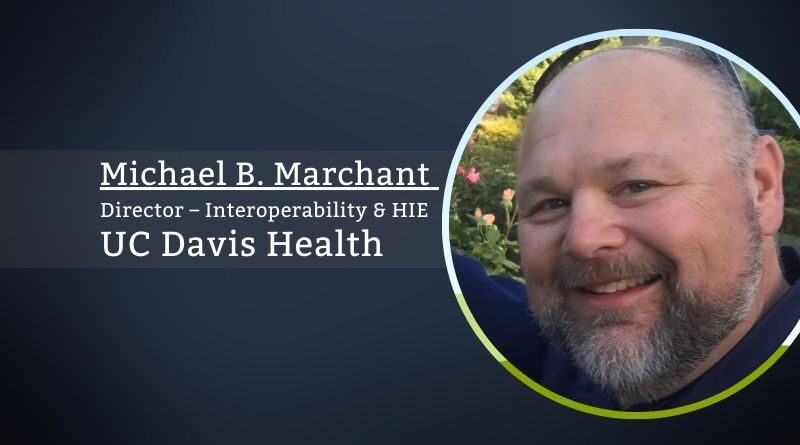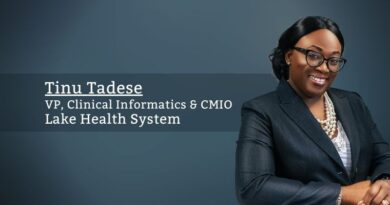From the Crow’s Nest: The Search for Perfect Health Data Exchange
By Michael B. Marchant, Director – Interoperability & HIE, UC Davis Health
It is 2025; you are on your way to a 10 am appointment with your PCP (primary care provider). You receive a text with a link to their wayfinding app which provides directions to your on-site parking space. Once you park, you receive a 2nd text that provides access to a wayfinding application that gives you turn-by-turn directions to your provider’s office. As you walk into the building, facial recognition checks you into your appointment and a 3rd text connects you with the ‘virtual clipboard’ where you can confirm/update your demographic, insurance and clinical information, the reason for your visit, take a photo of your insurance card and generally complete any pre-visit information while you wait. Once you have completed the pre-visit paperwork, you are directed to exam room 3, where the turn-by-turn directions get you to the exam room, where you are greeted by your doctor.
The doctor has your chart up and is reviewing your recent imaging study from the local reference imaging site, as well as the lab work done last month during your pre-employment physical. They talk with you about your blood sugar, heart rates, ECG and activity levels that were sent from your apple watch. They also remind you to refill your blood pressure medication as the information received from the pharmacy/insurance company shows that you have not refilled your medication in the last 90 days (which provides only 30-day increments).
Some would consider this an ideal encounter with their provider organization and for the future patient, interoperability and health information exchange (HIE) that delivers the right data, at the right time, for the right person, to the right person, across multiple states, systems and organizations are required for that reality. All of that exchange would be done directly, between participating organizations and their IT systems, magically behind the scenes, with no manual intervention by the patient nor the provider would be the expectation, but it’s far from today’s reality.
People suggest that healthcare interoperability falls short of other industries, for example, banking, but there is no data exchange between banks until you present your ‘card’. Banking also has the credit reporting agencies – Experian, TransUnion, and Equifax – which aggregate your financial information – which is reported directly to them by the banks – there is no such corollary in healthcare.
In today’s world – information is knowledge, power, currency, and the key to ensuring you and your loved ones get the right care, at the right time, in the right setting (without additional costs).
Health Information Exchange (the verb) has been fraught with patient identity issues. Specificity the usability, timeliness, manner of transmission, workflow integration and so on – the list of barriers exceeds the list of accomplishments on many fronts, but the foundational layer of digitized health data was brought forward by the EHR incentive program rolled out in the 2010s. This program encouraged EHR adoption amongst the provider communities, supported by technical and training resources from Regional Extension Centers and sped forward with the more recent expansion of health data exchange requirements via 21st Century Cures and TEFCA. These regulatory instruments have provided additional guardrails that are moving healthcare interoperability and standards adoption forward to reduce, remove, and eliminate a number of those barriers.
The future-forward interoperability framework will need the authority and ability to identify actors, create and deliver consent, and allow for health information to be participants in every exchange.
Still to be resolved are issues around patient, provider, and organizational identities. These are foundational components necessary to facilitate health information exchange and puts data in the right place to enable the best possible care encounter for each patient (think personalized medicine). The future-forward interoperability framework will need the authority and ability to identify actors, create and deliver consent and allow for health information to be participants in every exchange.
Organization Directory services for FHIR APIs and the like still need a home as well as a vetting authority to provide a trust framework for the consortia to be comfortable with making any exchange – patient identity with a consent mechanism that enables seamless and informed exchange also needs a home. Not to mention the need for an architecture that enables a ‘single patient identifier’ that can be shared by the patient with each of the care providers/organizations at the beginning of each encounter.
This global identifier could then be connected to the overall exchange framework and enable patient notification (and consent) of any exchanges between organizations, directly by the patient. Ideally, the industry creates that capability to enable a patient with a technology that easily supports record tracking and aggregation (think longitudinal health record) where encounters with each organization and provider are ‘logged’ with the identity of the patient and connection methodology for the organization. That ‘log’ could then be accessed by the network to connect and collect appropriate data via the supported methodology for each organization.
The future of just-in-time interoperability, where the right, correct and appropriate data arrives at the right time, in the correct system workflow for each ‘data consumer’ and it will require the implementation of trusted identity services to be in place for all participants/actors who are part of the health information exchange data fabric.
The penultimate goal is to enable a health data fabric where each ‘data consumer’ participating in the exchange gets the information needed to facilitate all clinical and administrative aspects of each encounter. That exchange should not be associated with significant costs, should happen in real-time, and enhance the quality of each individual encounter. This ultimately leads to the improved overall health of the patient and reduced costs, which so far has been the ‘Moby Dick’ of health data interoperability.



